Britain Confronts the Empire’s Monumental Murderers

The bitterly divisive spectacle staged by President Trump in front of Mount Rushmore on Friday was powerful proof once again that iconic statues of heroes from the past are social and political flashpoints in the present—not only in the U.S. but around the world. This is the second of three essays examining the often ambiguous and surprising history behind public monuments in France, in England, and in Hong Kong.
THE SHARK OF THE ATLANTIC
LONDON—Hilary Banks, 68, a stalwart of Bristol’s Jamaican community, was sitting at home last month when her granddaughter called her to ask, “Are you OK?”
Banks switched on the TV to see a crowd of Black Lives Matter protesters pulling down the statue of a man who captured and enslaved 84,000 African people. Until recently he was so revered in Bristol that school children would celebrate his birthday once a year with a special church ceremony and his favorite flowers, chrysanthemums.
Nazis Took Down the Statue of This Great Black General of the French Revolution
As Banks watched the television images of protesters rolling the statue of Edward Colston down the street and dumping him into the harbor, she felt both joy and anxiety.
“It evoked a lot,” she recalls. “The rope thrown around its neck felt like a lynching. When it was being pushed down the street, that screeching sound... I could literally hear the people who had been captured, screaming, ‘I don't wanna be in this place.’ As the deputy governor of the Royal African Company, Colston was responsible for the deaths of approximately 19,000 people whose bodies were thrown from slave ships into the sea. A truism of that gruesome traffic held that, “The shark of the Atlantic has ever been the partner of the slave trader.”
Campaigners have been wrestling with the legacy of Colston in Bristol for years, and recently there were heated debates over the wording of a proposed plaque beneath his statue exposing the brutality of Colston’s deadly commerce in human beings. But the plaque was blocked in 2018 by the Merchant Venturers, a secretive group of powerful and wealthy self-described “leaders in Bristol.”
The Society of Merchant Venturers is an 800-year old invitation-only group of predominantly elderly white men (the first woman joined in 2003, the first Black person in 2020) who wield great influence over the city’s political and economic life.
For years in the 18th and early 19th century, the society controlled Bristol’s involvement with slavery; today, they bill themselves as a philanthropic charity. But much of their present wealth is rooted in fortunes made by “the trade.”
Colston had been a member of the Merchant Venturers, which inherited his wealth when he died and helps to manage his legacy today. (Among other things, they put the remains of Colston’s fingernails and hair on display at the Merchant Venturers headquarters until 2016.)
The voice of Denis Burns, a former master of the Merchants and now Chair of Bristol University, tenses on the phone when asked if he worries the Merchant Venturers' activities may be discredited in light of recent events. “They could have been better at getting more diverse membership,” he says. “But essentially you’ve 80 people spending an awful lot of time and energy trying to do good things for the city of Bristol.”
A SUICIDAL SOCIOPATH CONQUEROR
The toppling of Colston’s statue in Bristol, along with the Black Lives Matter protests that have taken place across the United Kingdom and around the world since the killing of George Floyd, has fueled debates over how Britain remembers its brutal history. The statue of 19th century colonialist Cecil Rhodes has (almost) fallen in Oxford, and the statue of slaver Robert Milligan was removed swiftly and unceremoniously in London.
Indeed, the mayor of London has announced a review of all monuments here. But as the controversy continues it’s obvious the Merchant Venturers are not the only “grand” group nervous about the prospect of tweaking public monuments and other memorabilia dedicated to Britain's ex-empire.
In London’s Whitehall, outside the Foreign and Commonwealth Office, there is an imposing statue of Robert Clive on a high pedestal, put there in 1912 almost 140 years after his death at a moment when Britain felt the need to reconfirm its global might.
Clive’s victory over the French and their ally the Nawab of Bengal in 1757 had opened the way for the rapacious domination of the subcontinent by England’s East India Company. The administration he created looted the wealth of the land and starved the people, leading to a famine that cost at least a million lives.
Even by the standards of Britain’s brutal mercantilism, Clive came to be considered beyond the pale. In William Dalrymple’s recent epic history The Anarchy: The East India Company, Corporate Violence, and the Pillage of an Empire, he calls Clive an “unstable sociopath,” and a “violent, utterly ruthless and intermittently unstable corporate predator.”
“He was mentally unwell. He twice tried to commit suicide in his youth. He was suffering from serious depression throughout his stint in India and even after his return, and he ended up cutting his own wrist. He was a very troubled man,” Dalrymple recently told The Indian Express. “He was morose and hardly spoke. He was a depressive guy.”
By 1774 when Clive finally succeeded in taking his own life, he was said to be one of the most hated men in England. He was buried in an unmarked grave.
When the unrepentant imperialist Lord Curzon set out to resurrect Clive’s reputation early in the last century and had the statue of Clive erected only two years before the beginning of World War I, it was an undeniable statement: that the Empire did what it wanted where it wanted, with no regrets.
But today there is no Empire. And there are, or should be, many regrets.

Some 50,000 people have signed a petition to remove the Clive statue. The campaign was started by Meera Somji and Ameya Tripathi, both postgrad students in London. Two days after they watched Colston’s statue falling on Twitter, they cycled to the statue of Clive, took out a piece of cardboard and wrote a message: It's time to stop being proud of the British Empire. Clive: Looter of Bengal and placed it in front of the statue. “When we were in the park we overheard someone saying: he’s next,” Tripathi tells us.
Somji had seen Clive’s statue a few years earlier, when she’d gone on an Open Day tour of the Foreign Office. “Wow, really smart people work here,” she had assumed at the time. Once inside, she noted a number of paintings on the walls, including several featuring small Black children as servants, a common trope of colonial art. “I remember the tour guide being like: ‘We do what we can to preserve the history of the building that we’re working in.’ There was a nod to it, but it was all very… don’t spend too long looking at it, move on quickly now.”
Every year, a new cohort of young graduates at the Foreign Office remark on the disturbing art hanging on the walls. In recent weeks, Somji has spoken to an employee at the Foreign Office, who, she says, told her that the Foreign Office is increasingly concerned: “If staff start questioning what’s inside, then they’ll start questioning how Britain presents itself to other countries.”
For example, British overseas diplomats “are expected to act in a very grand way.” These days, the Foreign Office cares about diversity programs, but it also wants to “cultivate its office as the imperial center. They want people to say ‘wow’ when they walk in.”
In June, someone on a Foreign Office Zoom call leaked a quote to the Daily Mail. Apparently the Foreign Office’s most senior diplomat on the call, Permanent Secretary Sir Simon McDonald, had conceded that Clive “may have to go,” along with some of the racist art inside the Foreign Office. Later the Foreign Office distanced itself from McDonald, saying there were “no plans” to take down the statue.
A ‘WILBERFARCE’
For years, no visitor to Bristol would have guessed it was once Britain’s most important slaving port. (One small plaque was put up on the city docks in 1997.) Then, in 2006, the British government decided to plan a series of events to commemorate the 200th anniversary of Britain’s abolition of the transatlantic slave trade. For Bristol’s city council, marking the occasion was an opportunity to beat Liverpool to become “cultural city of the year” in 2008.
Many Black residents, however, worried that the events would become a “Wilberfarce”: a “self-congratulatory” celebration of William Wilberforce, the British politician who campaigned to end the slave trade with Africa. (Slavery as such did not end in many of Britain’s colonies until the 1830s.) Jendayi Serwah, a leading educator in Bristol, described the city’s initial commemoration plan as “a propaganda tool... which presents the oppressor in the role of the liberator.” Hilary Banks, meanwhile, said at the time that Bristol Council “would have us singing and dancing on the ships.”
In the event, the Bristol city council set up a legacy commission to allocate £750,000 over three years.
Jendayi Serwah, on watching the activists pull down statues, wonders how far this will go. “You’re chipping away at road signs and statues and buildings,” she says, but “if you took the whole unjust enrichment that led to the industrial revolution, British people would have nothing left. Your entire heritage is built on the exploitation and subjugation of others…. If you removed it all, you would be naked.”
Get our top stories in your inbox every day. Sign up now!
Daily Beast Membership: Beast Inside goes deeper on the stories that matter to you. Learn more.

 Yahoo News
Yahoo News 